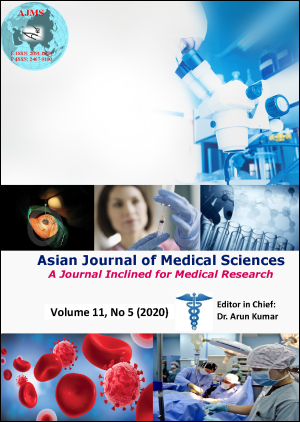A prospective observational study on the effectiveness of risk of malignancy index score (RMI 3) in a tertiary care centre in Eastern India
Keywords:
Adnexal mass, Ovarian malignancies, Serum CA-125, Risk of Malignancy Index-3Abstract
Background: Adnexal mass is a common presentation in today’s gynecological practice. The incidence of ovarian cancer is increasing day by day and diagnosis is often difficult to be made pre operatively with inadequate surgical exploration is a regular occurrence.
Aims and Objectives: To assess and validate the importance of RMI-3 score as pre-operative diagnostic tool of differentiating benign from malignant adnexal mass for starting first line therapy of ovarian cancer and to find out the incidences of ovarian malignancy among study population.
Material and Methods: The study was conducted in the Department of Gynecology and Obstetrics on (n=115) patients attending GOPD and indoor with adnexal mass fulfilling the inclusion and exclusion criteria using purposive sampling technique. All the selected cases underwent ultrasonography and serum CA- 125 level estimation necessary for calculating RMI score. A score of >200 was taken as suggestive of malignancy and confirmatory diagnosis was performed by histopathological examination obtained from staging laparotomy of adnexal mass. The individual scores were then correlated with final outcomes with statistical analyses.
Results: The study revealed benign ovarian tumors are more under 50 years (78.46%) and patients with normal BMI are diagnosed with maximum of malignancy (n = 28). History of tubal ligation carried less risk of malignancy (p<0.0001). Histologically malignant tumors found mostly in 71.4% postmenopausal group whereas 94.1% benign pathology were present in perimenopausal group and there is no association found between parity and histopathology (p=0.058). Bilateral (p=0.013), multilocular (p=0.000) tumors with solid areas (p<0.0001) and thick papillary projections (p<0.0001) had statistically significant association with malignant lesions. RMI score (>200) had more efficacy than serum CA-125 level (>46) in differentiating malignant lesions from benign one in terms of specificity (96% vs 83.87%) and positive predictive value (95% vs 79.17%).
Conclusions: RMI-3 score is a simple, reliable and effective tool in differentiating benign from malignant adnexal masses thereby help in quick referral and management of cases with increase chances of survival of the patients.
Downloads
Downloads
Published
How to Cite
Issue
Section
License
Authors who publish with this journal agree to the following terms:
- The journal holds copyright and publishes the work under a Creative Commons CC-BY-NC license that permits use, distribution and reprduction in any medium, provided the original work is properly cited and is not used for commercial purposes. The journal should be recognised as the original publisher of this work.
- Authors are able to enter into separate, additional contractual arrangements for the non-exclusive distribution of the journal's published version of the work (e.g., post it to an institutional repository or publish it in a book), with an acknowledgement of its initial publication in this journal.
- Authors are permitted and encouraged to post their work online (e.g., in institutional repositories or on their website) prior to and during the submission process, as it can lead to productive exchanges, as well as earlier and greater citation of published work (See The Effect of Open Access).




